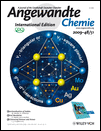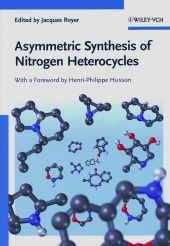Journal list menu
Export Citations
Download PDFs
Cover Picture
Cover Picture: Two-Dimensional Triangular and Square Heterometallic Clusters: Influence of the Closed-Shell d10 Electronic Configuration (Angew. Chem. Int. Ed. 51/2009)
- Page: 9567
- First Published: 08 December 2009

Guilded Rafts …︁ can be formed by heterometallic clusters. In their Communication on page 9663 ff., P. Braunstein, M. Bénard et al. describe the synthesis, structure, and theoretical analysis of a unique series of 2D raft mixed-metal clusters of the type {M[m]}n (M=Cu, n=3; M=Ag, Au, n=4; the bridging metalloligand [m] is {MoCp(CO)3}). Intramolecular, metallophilic d10⋅⋅⋅d10 interactions occur in the ν2-triangular (M=Cu) or ν2-square (M=Ag, Au) structures of the metal cores.
Inside Cover
Inside Cover: Far-Field Nanodiagnostics of Solids with Visible Light by Spectrally Selective Imaging (Angew. Chem. Int. Ed. 51/2009)
- Page: 9568
- First Published: 08 December 2009

The spatial resolution of a microscope based on focusing optics is restricted by the Abbe diffraction limit. In their Communication on page 9747 ff., A. V. Naumov, J. Köhler, and co-workers show that far-field imaging and spectroscopy of a giant ensemble of single fluorescent molecules provides structural information about the polycrystalline sample on a nanometer length scale, which is well below the Abbe limit. The obtained image reveals clear correlations between the locations of the chromophores and their spectral properties.
Graphical Abstract
Graphical Abstract: Angew. Chem. Int. Ed. 51/2009
- Pages: 9571-9580
- First Published: 08 December 2009
News
Spotlights on our sister journals: Angew. Chem. Int. Ed. 51/2009
- Pages: 9584-9586
- First Published: 08 December 2009
Author Profile
News
Solid-State Chemistry: M. Jansen Awarded / Inorganic Chemistry: Prize for P. J. Stang / Organic Chemistry: A. de Meijere Honored
- Page: 9589
- First Published: 08 December 2009
Book Reviews
Asymmetric Synthesis of Nitrogen Heterocycles. Edited by Jacques Royer.
- Page: 9590
- First Published: 08 December 2009
Elements of Synthesis Planning. By R. W. Hoffmann.
- Pages: 9590-9591
- First Published: 08 December 2009
Highlight
Transition-Metal Catalysis
Stereoselective Synthesis of β-Chlorovinyl Ketones and Arenes by the Catalytic Addition of Acid Chlorides to Alkynes
- Pages: 9592-9594
- First Published: 08 December 2009

New cats, new tricks: Complementary iridium catalysts enable the Z-selective catalytic addition of acid chlorides to alkynes. Depending on the ligand, the reaction proceeds with or without decarbonylation to give β-chlorovinyl-substituted arenes or ketones: useful intermediates for the synthesis of heterocycles. cod=cyclooctadiene, IPr=1,3-bis(2,6-diisopropylphenyl)imidazol-2-ylidene), RuPhos=2-dicyclohexylphosphanyl-2′,6′-diisopropoxy-1,1′-biphenyl.
Correspondence
Chemistry Databases
Polymer Backbone Conformation—A Challenging Task for Database Information Retrieval
- Pages: 9596-9598
- First Published: 08 December 2009

Look again: The X-ray single crystals structure determination of polyethylene glycol chains reported at the beginning of 2009 was not the first X-ray structure. The fact that old fiber and freeze-dried structure reports from the 1960s were overlooked points out weak spots in searches of chemical and crystallographic databases.
Minireview
Chiral Resolution
From Ostwald Ripening to Single Chirality
- Pages: 9600-9606
- First Published: 08 December 2009

The rich get richer and the poor get poorer: More than 100 years ago the 1909 Nobel laureate Wilhelm Ostwald explained how large crystals grow at the expense of small crystals. This principle forms the basis for the recently discovered method for the conversion of racemic crystal mixtures into homochiral crystals by grinding-induced attrition.
Review
Indole Chemistry
Catalytic Functionalization of Indoles in a New Dimension
- Pages: 9608-9644
- First Published: 08 December 2009

The “Lord of the Rings”: The direct chemical manipulation of the indole system is a long-standing synthetic shortcut to challenging molecular architectures which recently entered a new dimension through the introduction of innovative catalytic systems and techniques. This Review highlights the new aspects that have had made a deep impact on this topic over the last few years: efficiency, selectivity, and environmental friendliness.
Communications
Fullerene Nanostructures
Controlled Fabrication of Fullerene C60 into Microspheres of Nanoplates through Porphyrin-Polymer-Assisted Self-Assembly†
- Pages: 9646-9651
- First Published: 08 December 2009

Holey balls! Novel microspheres made up of nanoplates have been fabricated by porphyrin-polymer-assisted supramolecular self-assembly of C60. The obtained C60 microspheres are single-crystalline and exhibit pure fcc structure. This is a rare example of a hierarchical supramolecular architecture fabricated by the self-assembly of unmodified C60.
Asymmetric Synthesis
Chiral Phosphoric Acid Catalyzed Desymmetrization of meso-1,3-Diones: Asymmetric Synthesis of Chiral Cyclohexenones†
- Pages: 9652-9654
- First Published: 08 December 2009
Nanoparticle Superlattices
Observation of a Ternary Nanocrystal Superlattice and Its Structural Characterization by Electron Tomography†
- Pages: 9655-9657
- First Published: 08 December 2009
Protein Labeling
A Biocompatible Condensation Reaction for the Labeling of Terminal Cysteine Residues on Proteins†
- Pages: 9658-9662
- First Published: 08 December 2009

Going live: A protein-labeling method based on the use of a single amino acid tag—an N-terminal cysteine residue—and small-molecule probes containing a cyanobenzothiazole (CBT) unit has been used for the specific fluorescence labeling of proteins in vitro and at the surface of live cells (see scheme). This simple ligation reaction proceeds with a high degree of specificity under physiological conditions. Rd: a rhodamine dye; TEV: tobacco etch virus.
Metal–Metal Interactions
Two-Dimensional Triangular and Square Heterometallic Clusters: Influence of the Closed-Shell d10 Electronic Configuration†
- Pages: 9663-9667
- First Published: 08 December 2009

Gilded rafts: Oligomeric 2D raft clusters {M[m]}n (M=Cu, n=3; M=Ag or Au, n=4; see picture) with the same bridging metalloligand [m]={CpMo(CO)3} were prepared and structurally characterized. The ν2-triangular (M=Cu) or ν2-square (M=Ag, Au) structures of their metal–metal-bonded cores allow comparative evaluation of the d10⋅⋅⋅d10 interactions, and theoretical calculations point to a favorable contribution of diagonal Au⋅⋅⋅Au or Ag⋅⋅⋅Ag interactions.
Arsenic Detection
Use of Gold Nanoparticles in a Simple Colorimetric and Ultrasensitive Dynamic Light Scattering Assay: Selective Detection of Arsenic in Groundwater†
- Pages: 9668-9671
- First Published: 08 December 2009

Low level: The amount of arsenic in Bangladeshi well water and in bottled drinking water and Mississippi tap water are indicated by a dynamic light scattering (DLS) assay. Label-free gold nanoparticles are used in a selective colorimetric assay (see picture) and in a highly sensitive DLS assay for the recognition of arsenic in concentrations as low as 3 ppt.
Oxidation Photocatalysis
Homogeneous Photocatalytic Oxidation of Alcohols by a Chromophore–Catalyst Dyad of Ruthenium Complexes†
- Pages: 9672-9675
- First Published: 08 December 2009

A chromophore–catalyst dyad assembly of ruthenium polypyridyl complexes has been prepared, structurally and electronically characterized, and its proton-coupled multielectron photooxidation reactivity demonstrated by the visible sunlight-driven catalytic oxidation of aliphatic and benzyl alcohols into their corresponding aldehydes or ketones with high selectivities and over 100 turnover cycles in water, at ambient conditions.
Membrane-Binding Peptides
RE Coil: An Antimicrobial Peptide Regulator
- Pages: 9676-9679
- First Published: 08 December 2009

Peptides that make bacteria RE coil: A peptide system designed to regulate antimicrobial intervention switches between antimicrobial and inactive forms. The regulator comprises two α-helical sequences. One of them, R coil, binds to microbial membranes and acts as an antimicrobial component, and is inactivated by the other, E coil, a membrane-inactive peptide (see picture).
Photovoltaic Devices
Synthesis and Photoelectrochemical Study of Vertically Aligned Silicon Nanowire Arrays†
- Pages: 9680-9684
- First Published: 08 December 2009

Wiring photoelectrodes: Vertically aligned silicon nanowires were chemically synthesized and tested for solar-energy harnessing. Growth experiments reveal that such nanowire arrays can be obtained when the growth is slow. Photoelectrochemical studies validate that silicon nanowires are promising candidates for efficient solar cells.
Protein–Protein Interactions
Design and Synthesis of Highly Potent and Plasma-Stable Dimeric Inhibitors of the PSD-95–NMDA Receptor Interaction†
- Pages: 9685-9689
- First Published: 08 December 2009

On the double: Dimerization of monomeric peptide ligands towards the PDZ domains of the protein PSD-95 (postsynaptic density 95) leads to potent inhibitors of protein–protein interactions with stability in blood plasma. Optimization of the length of the polyethylene glycol linker results in unprecedented affinity for inhibitors of the PDZ1-2 domain (see picture).
Cascade Reactions
Palladium-Catalyzed Intramolecular Carboesterification of Olefins†
- Pages: 9690-9692
- First Published: 08 December 2009

One catalyst, three bonds: The title reaction between propiolic acids and unactivated olefins (see scheme; O red, Cl green) results in vicinal functionalization of the olefin, with the formation of new CC and CO bonds. Structurally complex 6,7,5-tricyclic ring systems are formed in a single step by this cascade chloropalladation and formal [3+2] cycloaddition.
Tandem Reactions
Concise One-Pot Tandem Synthesis of Indoles and Isoquinolines from Amides†
- Pages: 9693-9696
- First Published: 08 December 2009

Heterocyclic hot pot: Platinum(II)-catalyzed syntheses of indoles and isoquinolines from isocyanates, which are derived from a Hofmann-type rearrangement of amides using a hypervalent iodine reagent, are described. C2-symmetric macrocyclic bis(indole)s can also be synthesized from transannulation of C2-symmetric macrocyclic bis(alkyne carbamate) intermediates.
Cluster Formation
Spectroscopic Elucidation of First Steps of Supported Bimetallic Cluster Formation†
- Pages: 9697-9700
- First Published: 08 December 2009

Initial steps of bimetallic Ru–Os cluster formation on MgO in the presence of H2 are analyzed by EXAFS and IR spectroscopy. RuOs bond formation takes place after decarbonylation of Ru3 clusters and subsequently, at higher temperatures, of Os3 clusters to generate coordinative unsaturation (see scheme).
Main-Group Chemistry
N-Heterocyclic Carbene Stabilized Digermanium(0)†
- Pages: 9701-9704
- First Published: 08 December 2009
Synthetic Methods
Strain Release in CH Bond Activation?†
- Pages: 9705-9708
- First Published: 08 December 2009

What a relief! In 1955, strain release was put forward as a reactivity factor to explain the differing reactivity of axial and equitorial alcohols during oxidation. The same rationale may account for the differing rates of activation between axial and equitorial CH bonds in CH activation processes (see scheme).
Zinc Complexes
Bridging Binding Modes of Phosphine-Stabilized Nitrous Oxide to Zn(C6F5)2†
- Pages: 9709-9712
- First Published: 08 December 2009

Just say NNO: Reaction of [tBu3PN2O(B(C6H4F)3)] with 1, 1.5, or 2 equivalents of Zn(C6F5)2 affords the species [{tBu3PN2OZn(C6F5)2}2], [{tBu3PN2OZn(C6F5)2}2Zn(C6F5)2], and [tBu3PN2O{Zn(C6F5)2}2] (see structure; red Zn (large sphere), O (small sphere), green N, yellow P) displaying unique binding modes of Zn to the phosphine-stabilized N2O fragment.
Tandem Reactions
Tertiary Amine Mediated Tandem Cross-Rauhut–Currier/Acetalization Reactions: Access to Functionalized Spiro-3,4-Dihydropyrans†
- Pages: 9713-9716
- First Published: 08 December 2009

γ-Proton transfer furnished the highly selective title reaction in which cyclic β-haloenals 1 react with β,γ-unsaturated α-ketoesters 2 to generate functionalized spiro-3,4-dihydro-2H-pyrans 3 having an α-quaternary carbon center and an adjacent vinyl halide group in skeleton. DBU=1,8-diazabicyclo[5.4.0]undec-7-ene, Tos=4-toluenesulfonyl.
Directed Ferration
Preparation of Functionalized Aryl Iron(II) Compounds and a Nickel-Catalyzed Cross-Coupling with Alkyl Halides†
- Pages: 9717-9720
- First Published: 08 December 2009

The ortho-ferration of functionalized arenes using tmp2Fe⋅2 MgCl2⋅4 LiCl furnishes the corresponding diorgano FeII reagents at 25 °C in high yields. These reagents undergo cross-coupling reactions in the presence of 4-fluorostyrene to give various alkylated arenes. It turned out that NiII impurities present in commercial FeCl2 (98 % pure) catalyzed this alkyl–aryl cross-coupling reaction.
Host–Guest Chemistry
A Facile and Efficient Preparation of Pillararenes and a Pillarquinone†
- Pages: 9721-9723
- First Published: 08 December 2009
Chitin in Biosilica
Chitin-Based Organic Networks: An Integral Part of Cell Wall Biosilica in the Diatom Thalassiosira pseudonana†
- Pages: 9724-9727
- First Published: 08 December 2009

Inner workings: Diatom cell walls are outstanding examples of natural hybrid materials and exhibit interesting mechanical and optical properties. Removal of the biosilicates in the cell walls of T. pseudonana with NH4F proves that the cell walls contain an internal, organic network consisting of crosslinked chitin fibers as well as other organic components (see picture).
DNA Quadruplexes
Human Telomeric Quadruplex Conformations Studied by Pulsed EPR†
- Pages: 9728-9730
- First Published: 08 December 2009

Distance learning: Under physiological conditions telomeric sequences adopt different quadruplex topologies, although the exact nature of these species is currently debated. Double spin-labeled oligonucleotides consisting of guanosine-rich telomeric repeats are synthesized and characterized by pulsed EPR techniques. In solution in the presence of K+ ions the propeller and basket quadruplex conformations co-exist as a 1:1 mixture.
Metal Aerogels
Hydrogels and Aerogels from Noble Metal Nanoparticles†
- Pages: 9731-9734
- First Published: 08 December 2009

Look, no hands! Non-supported macroscopic aerogels are fabricated from platinum, gold, and silver, and from bimetallic mixtures of gold/silver and platinum/silver. The hydrogels and aerogels consist of voluminous porous networks of particles or wires that are only a few nanometers thick. These entirely new structures have tremendous potential for applications in catalysis and nanophotonics.
Gold–Boron Interactions
A Trimetallic Gold Boride Complex with a Fluxional Gold–Boron Bond†
- Pages: 9735-9738
- First Published: 08 December 2009

Gold–boron (con)fusion: Addition of an anionic metalloborylene to an [AuCl(N-heterocyclic carbene)] complex results in attack of the boron atom at the gold center and formation of a trimetallic Mn2AuB framework (see scheme, middle). X-ray structural analysis and DFT calculations show that the bonding situation of this complex cannot be described by the “boryl” (pure boron donor) or “borane” (pure boron acceptor) descriptions.
RNA Folding
Ca2+ Induces the Formation of Two Distinct Subpopulations of Group II Intron Molecules†
- Pages: 9739-9742
- First Published: 08 December 2009

New wrinkles in folding: In the folding of the D135 ribozyme derived from the group II intron Sc.ai5γ, partial replacement of Mg2+ with Ca2+ leads to a division into two distinct subpopulations that are not interchangeable. The picture shows the splitting into the two types together with the single-molecule FRET states.
Sulfur Oxidation
Sulfur Oxidation on Pt(355): It Is the Steps!†
- Pages: 9743-9746
- First Published: 08 December 2009

Steps in the right direction: The role of steps in the removal of sulfur from a Pt model catalyst, via metastable SO3 and SO4 species, was demonstrated by in situ high-resolution X-ray photoelectron spectroscopy. From isothermal experiments the activation energy of the rate-determining step was deduced to be 34 kJ mol−1.
Single-Molecule Imaging
Far-Field Nanodiagnostics of Solids with Visible Light by Spectrally Selective Imaging†
- Pages: 9747-9750
- First Published: 08 December 2009

Cracking up: Use of conventional microscopy allows the width of a crack in a crystal to be determined with an accuracy that is limited by classical diffraction (see picture, left-hand image). Single-molecule imaging methods enable the determination of the crack profile with an accuracy beyond the diffraction limit (right-hand image).
Preview
Preview: Angew. Chem. Int. Ed. 52/2009
- Page: 9755
- First Published: 08 December 2009















































